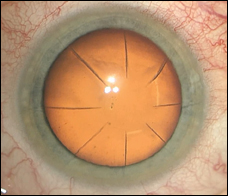Femtosecond laser enables safer cataract incisions after previous RK
The length and width of primary corneal and side-port incisions can be adjusted according to the number of existing RK incisions.
Femtosecond laser-assisted incisions may be safer and more accurate than manual incisions in eyes that undergo cataract surgery after previous radial keratotomy, a study found.
Patients undergoing cataract surgery after previous RK face various risks because RK incisions can reach up to 90% of total corneal thickness, the study authors said.
“After RK, there is a higher risk of corneal perforation when performing manual corneal incisions during cataract surgery,” Rozina Noristani, MD, the corresponding author, told Ocular Surgery News. “With the femtosecond laser, the corneal main and side-port incisions can be positioned very precisely between the RK incisions.”

Noristani noted that with live three-dimensional OCT scanning, RK incisions can be visualized and laser settings for corneal incisions can be individualized.
Study results were published in Journal of Refractive Surgery.
Technique
Six eyes of three patients underwent femtosecond laser-assisted cataract surgery performed with the Catalys Precision Laser System (Abbott Medical Optics). Two patients had eight RK incisions in each eye, and one patient had six incisions in each eye.
Three-dimensional spectral-domain OCT was performed after the patient’s eye was docked to the laser system.
The laser system recognized the anterior and posterior corneal surfaces and visualized the anterior and posterior lens capsule. The surgeon used the installed infrared camera to identify the RK incisions.

Image: Noristani R
Using the touch-screen function, the surgeon positioned the primary and side-port incisions between the RK incisions. Incision width was set at 27 mm; incision length was adjusted from 1.3 mm to 1.5 mm.
“Depending on the location of the RK incisions, the exact location of the primary or side-port incisions varied individually,” Noristani said. “Since the highest number of RK incisions in the presented cases was eight, there was always enough space to position the corneal incisions between the RK incisions. Here, the incision width and the length can be adjusted depending on the number of pre-existing RK-incisions.”
The anterior side-cut angle was 90° and the posterior side-cut angle was 45° for the primary and side-port incisions. Laser treatment was started after SD-OCT was used to confirm the correct position. Anterior capsulotomy, lens fragmentation, primary incision and side-port incisions were then performed.
Results
All corneal incisions were opened manually with a blunt spatula with no corneal perforation. All capsulotomies were complete and circular, with no tears or gaps; no anterior capsule tears were identified.
There were no intraoperative complications. The lens was aspirated in all cases without the use of ultrasound. No leakage was seen in incisional areas at 6 weeks or 6 months after surgery.
Corneal relaxing incisions can be performed in eyes with previous RK, Noristani said.
“However, it depends on the number of the RK incisions and the space between the incisions. The axis and the length of the incisions have to be guaranteed between the RK incisions,” she said.
Noristani noted that previous RK can affect IOL power calculations.
“There are many studies which could show that the eyes after RK develop a so-called hyperopic shift with an unstable cornea, which has to be considered when choosing the IOL power,” she said. – by Matt Hasson
- Reference:
- Noristani, R, et al. J Refract Surg. 2016;doi:10.3928/1081597X-20160428-03.
- For more information:
- Rozina Noristani, MD, can be reached at Ruhr University Eye Hospital, In der Schornau 23-25, 44892 Bochum, Germany; email: rozina.noristani@kk-bochum.de.
Disclosure: Noristani reports no relevant financial disclosures.

